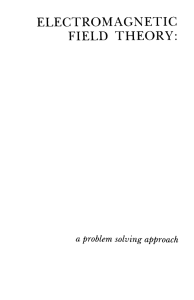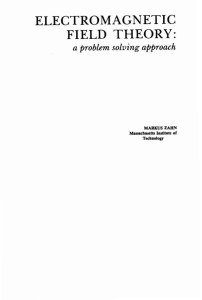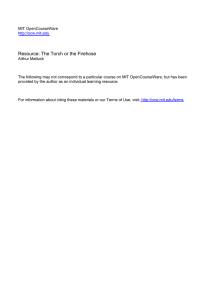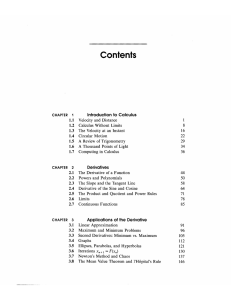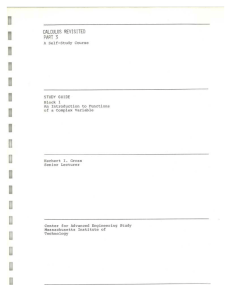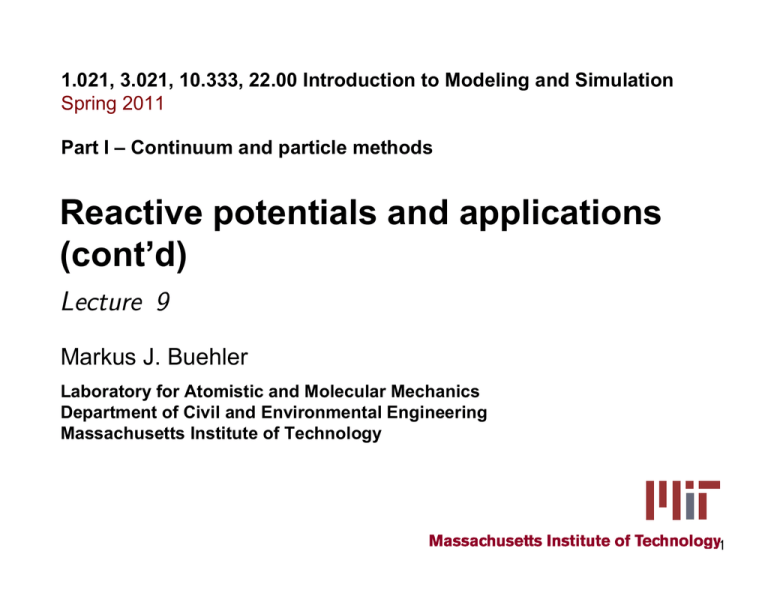
1.021, 3.021, 10.333, 22.00 Introduction to Modeling and Simulation
Spring 2011
Part I – Continuum and particle methods
Reactive potentials and applications
(cont’d)
Lecture 9
Markus J. Buehler
Laboratory for Atomistic and Molecular Mechanics
Department of Civil and Environmental Engineering
Massachusetts Institute of Technology
1
Content overview
I. Particle and continuum methods
1.
2.
3.
4.
5.
6.
7.
8.
Atoms, molecules, chemistry
Continuum modeling approaches and solution approaches
Statistical mechanics
Molecular dynamics, Monte Carlo
Visualization and data analysis
Mechanical properties – application: how things fail (and
how to prevent it)
Multi-scale modeling paradigm
Biological systems (simulation in biophysics) – how
proteins work and how to model them
II. Quantum mechanical methods
1.
2.
3.
4.
5.
6.
7.
8.
Lectures 2-13
Lectures 14-26
It’s A Quantum World: The Theory of Quantum Mechanics
Quantum Mechanics: Practice Makes Perfect
The Many-Body Problem: From Many-Body to SingleParticle
Quantum modeling of materials
From Atoms to Solids
Basic properties of materials
Advanced properties of materials
What else can we do?
2
Overview: Material covered so far…
Lecture 1: Broad introduction to IM/S
Lecture 2: Introduction to atomistic and continuum modeling (multi-scale modeling
paradigm, difference between continuum and atomistic approach, case study: diffusion)
Lecture 3: Basic statistical mechanics – property calculation I (property
calculation: microscopic states vs. macroscopic properties, ensembles, probability
density and partition function)
Lecture 4: Property calculation II (Monte Carlo, advanced property calculation,
introduction to chemical interactions)
Lecture 5: How to model chemical interactions I (example: movie of copper
deformation/dislocations, etc.)
Lecture 6: How to model chemical interactions II (EAM, a bit of ReaxFF—chemical
reactions)
Lecture 7: Application – MD simulation of materials failure
Lecture 8: Application – Reactive potentials and applications
Lecture 9: Application – Reactive potentials and applications (cont’d)
3
Lecture 9: Reactive potentials and applications
(cont’d)
Outline:
1. Notes on fracture application
2. Closure: ReaxFF force field
3. Hybrid multi-paradigm fracture models
Goal of today’s lecture:
Remarks: Modeling of fracture and relation to diffusion problem
New potential: ReaxFF, to describe complex chemistry (bond breaking
and formation)
Application in hybrid simulation approaches (combine different force
fields)
4
1. Notes on fracture application
Consider for pset #2
5
Brittle fracture mechanisms: fracture is a multiscale phenomenon, from nano to macro
Reprinted by permission from Macmillan Publishers Ltd: Nature.
Source: Buehler, M., and Z. Xu. "Materials Science: Mind the Helical Crack." Nature 464, no. 7285 (2010): 42-3. © 2010.
6
Limiting speeds of cracks: linear elastic
continuum theory
9E
cl =
8ρ
~ E
Mother-daughter mechanism
SuperSub-Rayleigh Rayleigh
Intersonic
cs =
Supersonic
Mode II
Mode I
Cr
Cs
Subsonic
Cl
Limiting speed v
3E
~ E
8ρ
cr = 0.92cs
Supersonic
Mode III
Cs
Linear
Cl
Limiting speed v
Nonlinear
Image by MIT OpenCourseWare.
• Cracks can not exceed the limiting speed given by the corresponding
wave speeds unless material behavior is nonlinear
• Cracks that exceed limiting speed would produce energy (physically
impossible - linear elastic continuum theory)
7
Subsonic and supersonic fracture
Under certain conditions, material nonlinearities (that is, the behavior of
materials under large deformation = hyperelasticity) becomes important
This can lead to different limiting speeds
than described by the model introduced above
Elarge (stiff)
or
he
rt
ea
Lin
Stress
enin
g
y
large deformation
nonlinear zone
“singularity”
Stiff
Deformation field
near a crack
1
σ (r) ~
r
ning
Softe
Hyperelasticity
Strain
small deformation
9E
cl =
~ E
8ρ
Image by MIT OpenCourseWare.
Esmall (soft)
8
Energy flux concept
Far away from crack tip
csmall (soft)
Llarge (stiff)
clarge (stiff)
Lenergy
Characteristic
energy
length
(energy from this
distance needs
to flow to the
crack tip)
Llarge (stiff)
Crack tip
Image by MIT OpenCourseWare.
Lenergy
≈ 1 Æ Supersonic
cracking
9
Energy flux reduction/enhancement
New
K dominance zone
Characteristic energy length
Hyperelastic zone
Fracture process zone
Image by MIT OpenCourseWare.
Lenergy
Energy flux related to wave speed: high local wave speed, high energy flux,
crack can move faster (and reverse for low local wave speed)
10
Physical basis for subsonic/supersonic fracture
Changes in energy flow at the crack tip due to changes in local wave
speed (energy flux higher in materials with higher wave speed)
Controlled by a characteristic length scale
Lenergy
Buehler et al., Nature, 2003
Reprinted by permission from Macmillan Publishers Ltd: Nature.
Source: Buehler, M., F. Abraham, and H. Gao. "Hyperelasticity Governs Dynamic
Fracture at a Critical Length Scale." Nature 426 (2003): 141-6. © 2003.
11
Diffusion problem
Fracture problem
Continuum approach (distinct PDE)
Integration
(BCs, ICs)
Characteristic
time of
diffusion
PDE (continuum
equilibrium)
∂c
d 2c
=D 2
∂t
dx
PDE
(Fick’s law)
Integration
(BCs, ICs)
Crack limiting
speed
Atomistic approach (same PDE)
Integration
(BCs, ICs)
© source unknown. All rights reserved. This content is excluded
from our Creative Commons license. For more information, see
http://ocw.mit.edu/fairuse.
Integration
(BCs, ICs)
Crack
limiting
speed
Characteristic time of diffusion
12
2. Closure: ReaxFF force field
Potential energy expressions for more
complex materials/chemistry, including
bond formation and breaking
13
Review: atomic interactions – different types of
chemical bonds
Primary bonds (“strong”)
Ionic (ceramics, quartz, feldspar - rocks)
Covalent (silicon)
Metallic (copper, nickel, gold, silver)
(high melting point, 1000-5,000K)
Secondary bonds (“weak”)
Van der Waals (wax, low melting point)
Hydrogen bonds (proteins, spider silk)
(melting point 100-500K)
Ionic: Non-directional (point charges interacting)
Covalent: Directional (bond angles, torsions matter)
Metallic: Non-directional (electron gas concept)
Difference of material properties originates from different atomic
interactions
14
But…are all bonds the same? - valency in
hydrocarbons
Ethane C2H6
(stable configuration)
All bonds are not the same!
Adding another H is not favored
H
Bonds depend on the environment!
15
Another challenge: chemical reactions
sp3
sp2
Energy
φstretch
Transition point ???
C-C distance
r
sp2
sp3
Simple pair potentials can not describe chemical reactions
16
Why can not model chemical reactions with springlike potentials?
1
2
φstretch = kstretch ( r − r0 ) 2
Set of parameters only valid for particular
molecule type / type of chemical bond
kstretch,sp 2 ≠ kstretch,sp3
Reactive potentials or reactive force fields overcome these limitations
17
Theoretical basis: bond order potential
Concept: Use pair potential that depends on atomic environment
(similar to EAM, here applied to covalent bonds)
Modulate strength of
attractive part
(e.g. by coordination,
or “bond order”)
Potential energy (eV)
5
0
-5
-10
0.5
1
1.5
2
2.5
3
3.5
o
Distance (A)
Triple
S.C.
Double
F.C.C.
Single
Effective pair-interactions for various C-C (Carbon) bonds
Abell, Tersoff
Image by MIT OpenCourseWare.
Changes in spring constant as function of bond order
Continuous change possible
= continuous energy landscape during chemical reactions
18
Theoretical basis: bond order potential
Potential energy (eV)
5
0
-5
-10
0.5
1
1.5
2
2.5
3
3.5
o
Distance (A)
Triple
S.C.
Double
F.C.C.
Single
Effective pair-interactions for various C-C (Carbon) bonds
Image by MIT OpenCourseWare.
D. Brenner, 2000
19
Concept of bond order (BO)
r
BO
sp3
1
sp2
2
sp
3
20
Bond order based energy landscape
Bond length
Bond length
Pauling
Bond order
Energy
Bond order potential
Allows for a more general
description of chemistry
All energy terms dependent
on bond order
Energy
Conventional potential
(e.g. LJ, Morse)
21
Historical perspective of
reactive bond order potentials
1985: Abell: General expression for binding energy as a sum of near
nieghbor pair interactions moderated by local atomic environment
1990s: Tersoff, Brenner: Use Abell formalism applied to silicon
(successful for various solid state structures)
2000: Stuart et al.: Reactive potential for hydrocarbons
2001: Duin, Godddard et al.: Reactive potential for hydrocarbons
“ReaxFF”
2002: Brenner et al.: Second generation “REBO” potential for
hydrocarbons
2003-2005: Extension of ReaxFF to various materials including
metals, ceramics, silicon, polymers and more in Goddard‘s group
22
Example: ReaxFF reactive force field
William A. Goddard III
California Institute of Technology
Courtesy of Bill Goddard. Used with permission.
Adri C.T. v. Duin
California Institute of Technology
23
ReaxFF: A reactive force field
Esystem = Ebond + EvdWaals + ECoulomb + Eval ,angle + Etors
2-body
3-body 4-body
+ Eover + Eunder
multi-body
Total energy is expressed as the sum of various terms describing
individual chemical bonds
All expressions in terms of bond order
All interactions calculated between ALL atoms in system…
No more atom typing: Atom type = chemical element
24
Example: Calculation of bond energy
Esystem = Ebond + EvdWaals + ECoulomb + Eval ,angle + Etors + Eover + Eunder
(
)
p
Ebond = − De ⋅ BOij ⋅ exp ⎡ pbe,1 1 − BOij be ,1 ⎤
⎣
⎦
Bond energy between atoms i and j does not depend on bond distance
Instead, it depends on bond order
25
Bond order functions
BO goes
smoothly
from 3-21-0
(1)
(2)
(3)
Fig. 2.21c in Buehler, Markus J. Atomistic Modeling
of Materials Failure. Springer, 2008. © Springer. All rights
reserved. This content is excluded from our Creative Commons
license. For more information, see http://ocw.mit.edu/fairuse.
(1) βσ
⎡
⎛ rij ⎞
⎢
BOij = exp ασ ⋅ ⎜ ⎟
⎢
⎝ r0 ⎠
⎣
(2)
⎡
⎤
⎥ + exp ⎢απ
⎢
⎥
⎦
⎣
(3)
⎡
⎛ rij ⎞ ⎤
⋅ ⎜ ⎟ ⎥ + exp ⎢αππ
⎢
⎝ r0 ⎠ ⎥⎦
⎣
π
βπ
ππ
⎛ rij ⎞
⋅⎜
⎟
r
⎝ 0 ⎠
βππ
⎤
⎥
⎥
⎦
Characteristic bond distance
All energy terms are expressed as a function of bond orders
26
Illustration: Bond energy
Image removed due to copyright restrictions.
Please see slide 10 in van Duin, Adri. "Dishing Out the Dirt on ReaxFF.”
http://www.wag.caltech.edu/home/duin/FFgroup/Dirt.ppt.
27
vdW interactions
E system = Ebond + EvdW aals + ECoulomb + Eval ,angle + Etors + Eover + Eunder
Accounts for short distance repulsion (Pauli principle
orthogonalization) and attraction energies at large distances
(dispersion)
Included for all atoms with shielding at small distances
Image removed due to copyright restrictions.
Please see slide 11 in van Duin, Adri. "Dishing Out the Dirt on ReaxFF.”
http://www.wag.caltech.edu/home/duin/FFgroup/Dirt.ppt.
28
Resulting energy landscape
Contribution of Ebond and vdW
energy
Source: van Duin, C. T. Adri, et al. "ReaxFF: A Reactive Force
Field for Hydrocarbons." Journal of Physical Chemistry A 105
(2001). © American Chemical Society. All rights reserved. This
content is excluded from our Creative Commons license. For more
information, see http://ocw.mit.edu/fairuse.
29
Current development status of ReaxFF
: not currently described by ReaxFF
Allows to interface metals, ceramics
with organic chemistry: Key for
complex materials, specifically
biological materials
Periodic table courtesy of Wikimedia Commons.
A--B
A
B
30
Mg-water interaction: How to make fire with water
Video stills removed due to copyright restrictions; watch the video now:
http://www.youtube.com/watch?v=QTKivMVUcqE.
Mg
http://video.google.com/videoplay?docid=4697996292949045921&q=magnesium+water&total=46&start=0&num=50&so=0&type=search&plindex=0
31
Mg – water interaction – ReaxFF MD simulation
32
3. Hybrid multi-paradigm fracture models
Focus: model particular fracture properties of
silicon (chemically complex material)
33
Fracture of silicon: problem statement
Pair potential insufficient
to describe bond breaking
(chemical complexity)
Image courtesy of NASA.
34
Multi-paradigm concept for fracture
Need method
“good” for describing
rupture of chemical bonds
1
σ (r) ~
r
r
Need method
“good” for elastic
properties (energy
storage)
Image by MIT OpenCourseWare.
35
What about combining different potentials?
Increased accuracy & “transferability”
Computational efficiency
Empirical models: mathematical functions with
parameters (fitted to experiment or quantum
mechanics)
Pair potentials (LJ, Morse, Buck., harmonic) (lecture 5)
Embedded atom models/effective medium theories
Multi-body potentials (e.g. Tersoff, CHARMM, etc.)
(lecture 9 and following)
Reactive potentials (ReaxFF) (lecture 9)
Semi-empirical models (explicitly note electronic
structure)
Tight binding
MINDO (=Modified Intermediate Neglect of Differential
Overlap), NINDO (=Intermediate Neglect of Differential
Overlap)
“good” for
elastic
properties
(energy
storage)
+
“good” for
describing rupture
of chemical bonds
=
“multi-paradigm
model”
Quantum mechanical models: Start from
Schroedinger’s equation (and make approximations
to be able to solve it)
Quantum chemistry (Hartree-Fock)
Density Functional Theory
Quantum Monte Carlo
After: G. Ceder
36
Concept: concurrent multi-paradigm
simulations
Crack tips, defects (dislocations)
FE (continuum)
nonreactive
atomistic
ReaxFF
Organic phase
Inorganic phase
nonreactive
atomistic
Interfaces (oxidation, grain boundaries,..)
• Multi-paradigm approach:
combine different computational
methods (different resolution,
accuracy..) in a single
computational domain
• Decomposition of domain
based on suitability of different
approaches
• Example: concurrent FEatomistic-ReaxFF scheme in a
crack problem (crack tip treated
by ReaxFF) and an interface
problem (interface treated by
ReaxFF).
37
Concurrent multi-paradigm simulations:
link nanoscale to macroscale
Concurrent coupling: use of multiple force fields within one
simulation domain
38
Simulation Geometry: Cracking in Silicon
Potential for covalent
bonds, not suitable
for bond breaking
Fig. 2 in Buehler, Markus J., et al. "Multiparadigm Modeling of
Dynamical Crack Propagation in Silicon Using a Reactive Force Field."
Physical Review Letters 96 (2006): 095505. © APS. All rights
reserved. This content is excluded from our Creative Commons
license. For more information, see http://ocw.mit.edu/fairuse.
• Consider a crack in a silicon crystal under mode I loading.
• Periodic boundary conditions in the z-direction (corresponding to a plane
strain case).
39
Cracking in Silicon: Hybrid model versus
Tersoff based model
Pure Tersoff
Hybrid
ReaxFF-Tersoff
Image by MIT OpenCourseWare.
Conclusion: Pure Tersoff can not describe correct crack dynamics
40
How is the handshaking achieved?
41
Hybrid potential energy model (Hamiltonian)
Weights = describe how much
a particular FF counts (assigned to each atom)
Wi
To obtain forces:
∂U tot ( x )
F =−
∂x
need potential
energy
W2
100%
0%
R-Rbuf
ReaxFF
W1
R+Rtrans R+Rtrans +Rbuf
R
Transition
layer
x
Tersoff
Transition region
Tersoff ghost atoms
ReaxFF ghost atoms
Image by MIT OpenCourseWare.
Approach: handshaking via mixed Hamiltonians
transition region
U tot = U ReaxFF + U Tersoff + U ReaxFF −Tersoff
42
Assigning weights to atoms
Wi
W2
100%
0%
R-Rbuf
ReaxFF
W1
R+Rtrans R+Rtrans +Rbuf
R
Transition
layer
x
Tersoff
Transition region
Tersoff ghost atoms
ReaxFF ghost atoms
Image by MIT OpenCourseWare.
Percentage ReaxFF
Percentage Tersoff
(relative contribution to
total energy)
100%
…
0%
…
100% 70% 30% 0% …
0% 30% 70% 100% …
0%
100%
43
Force calculation
Potential energy
Wi
U tot = U ReaxFF + U Tersoff + U ReaxFF −Tersoff
100%
U ReaxFF −Tersoff = wReaxFF ( x )U ReaxFF + (1 − wReaxFF )U Tersoff
0%
W1
W2
R-Rbuf
R
R+Rtrans R+Rtrans +Rbuf
x
Transition region
Recall: F = −
∂U
∂x
Image by MIT OpenCourseWare.
wReaxFF ( x ) + wTersoff ( x ) = 1
∀x
wReaxFF is the weight of the reactive force field in the handshaking region.
∂w
⎡
⎤
FReaxFF−Tersoff = − ⎢(wReaxFF ( x ) FReaxFF + (1 − wReaxFF ) FTersoff ) − ReaxFF (U ReaxFF − U Tersoff )⎥
∂x
⎣
⎦
44
D. Sen and M. Buehler, Int. J. Multiscale Comput. Engrg., 2007
Hybrid Hamiltonians – force calculation
∂w
⎤
⎡
FReaxFF−Tersoff = − ⎢(wReaxFF ( x ) FReaxFF + (1 − wReaxFF ) FTersoff ) − ReaxFF (U ReaxFF − U Tersoff )⎥
∂x
⎦
⎣
≈0
≈0
Slowly varying weights (wide transition region): ∂wReaxFF / ∂x ≈ 0
If U ReaxFF −U Tersoff ≈ 0 (i.e., both force fields have similar energy landscape)
Simplified result: can interpolate forces from one end to the other
FReaxFF −Tersoff = (wReaxFF ( x ) FReaxFF + (1 − wReaxFF ) FTersoff )
wReaxFF ( x ) + wTersoff ( x ) = 1
∀x
45
D. Sen and M. Buehler, Int. J. Multiscale Comput. Engrg., 2007
Energy landscape of two force fields
• Schematic showing the coupling of
reactive and nonreactive potentials
U
• At small deviations, energy
landscape is identical in nonreactive
and reactive models
x
U ReaxFF −U nonreactive ≈ 0
46
Summary: hybrid potential energy model
Wi
W2
100%
0%
R-Rbuf
ReaxFF
W1
R+Rtrans R+Rtrans +Rbuf
R
Transition
layer
x
Tersoff
Transition region
Tersoff ghost atoms
ReaxFF ghost atoms
Image by MIT OpenCourseWare.
FReaxFF −Tersoff = (wReaxFF ( x ) FReaxFF + (1 − wReaxFF ) FTersoff )
wReaxFF ( x ) + wTersoff ( x ) = 1
∀x
47
Fracture of silicon single crystals
Mode I tensile
Use multi-paradigm scheme that combines
the Tersoff potential and ReaxFF
Image by MIT OpenCourseWare.
0 ps
7.0 ps
ReaxFF
14.0 ps
Tersoff
Reactive region (red) is moving with crack tip.
Image by MIT OpenCourseWare.
Quantitative comparison w/ experiment
“empirical” FFs
Fig. 1c in Buehler, M., et al. "Threshold Crack Speed Controls Dynamical Fracture of Silicon Single
Crystals." Physical Review Letters 99 (2007). © APS. All rights reserved. This content is excluded from
our Creative Commons license. For more information, see http://ocw.mit.edu/fairuse.
Load: normalized by critical energy release rate to
initiate fracture
49
Crack dynamics
Image removed due to copyright restrictions. Please see: Fig. 2 in Buehler,
M., et al. "Threshold Crack Speed Controls Dynamical Fracture of Silicon
Single Crystals." Physical Review Letters 99 (2007).
Crack speed: O(km/sec)
=O(nm/ps) (well in
reach with MD)
50
Atomistic fracture mechanism
51
Fracture initiation and instabilities
52
Fracture mechanism: tensile vs. shear loading
Mode I tensile
Mode II shear
Shear (mode II) loading:
Crack branching
Tensile (mode I) loading:
Straight cracking
Image by MIT OpenCourseWare.
M.J. Buehler, A. Cohen, D. Sen, Journal of Algorithms and Computational Technology, 2008
53
Fracture mechanism: tensile vs. shear loading
Mode I tensile
Mode II shear
Shear (mode II) loading: Crack branching
Tensile (mode I) loading: Straight cracking
Image by MIT OpenCourseWare.
Images removed due to copyright restrictions.
Please see figures in Buehler, M. J., A. Cohen, and D. Sen. "Multi-paradigm Modeling
of Fracture of a Silicon Single Crystal Under Mode II Shear Loading."Journal of
Algorithms and Computational Technology 2 (2008): 203-21.
54
Summary: main concept of this section
Can combine different force fields in a single computational
domain = multi-paradigm modeling
Enables one to combine the strengths of different force fields
Simple approach by interpolating force contributions from
individual force fields, use of weights (sum of weights = 1 at all
points)
ReaxFF based models quite successful, e.g. for describing
fracture in silicon, quantitative agreement with experimental results
55
MIT OpenCourseWare
http://ocw.mit.edu
3.021J / 1.021J / 10.333J / 18.361J / 22.00J Introduction to Modeling and Simulation
Spring 2012
For information about citing these materials or our Terms of use, visit http://ocw.mit.edu/terms.

